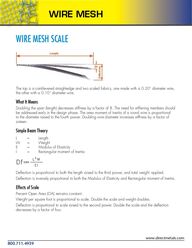
Return to flip book view
WIRE MESH800.711.4939www.directmetals.comThe top is a cantilevered straightedge and two scaled fabrics, one made with a 0.20” diameter wire, the other with a 0.10” diameter wire.What It MeansDoubling the span (length) decreases stiffness by a factor of 8. The need for stiffening members should be addressed early in the design phase. The area moment of inertia of a round wire is proportional to the diameter raised to the fourth power. Doubling wire diameter increases stiffness by a factor of sixteen.Simple Beam TheoryL = LengthW = WeightE = Modulus of ElasticityI = Rectangular moment of InertiaDeflection is proportional to both the length raised to the third power, and total weight applied.Deflection is inversely proportional to both the Modulus of Elasticity and Rectangular moment of Inertia.Effects of ScalePercent Open Area (OA) remains constant.Weight per square foot is proportional to scale. Double the scale and weight doubles.Deflection is proportional to scale raised to the second power. Double the scale and the deflection decreases by a factor of four.WIRE MESH SCALE
WIRE MESH800.711.4939www.directmetals.comWIRE MESH FUNDAMENTALSSpacing / Opening / Diameter RelationshipThe basic relationship between wire spacing, wire diameter and opening size is expressed by a simple algebraic relationship:wire spacing = wire diameter + opening sizeopening size = wire spacing - wire diameterwire diameter = wire spacing - opening sizeWire Mesh SpacingWire mesh spacing, is defined either as a measured distance expressed in inches, or as the number of openings per lineal inch expressed as a count. Wire Mesh DiameterMost industrial specifications are produced with round cross section wire. Whenever possible, refer to the wire mesh diameter in decimals of an inch, rather than gauge. Confusion between ferrous and non-ferrous gauge numbers and sheet steel numbers results in incorrect wire diametersbeing specified. Standard wire mesh diameters used are as follows:Wire Mesh Weight and ConversionsWeight is simply the weight per unit area. It is typically expressed as lbs. per square foot or kilograms per square meter. Generic weights per square foot displayed on this website are for steel. Conversion factors for other typical alloys are located in the table on the right:.035 .041 .047 .054 .063.072 .080 .092 .105 .120.135 .148 .162 .177 .192.207 .225 .250 .312 .375Standard Wire DiametersSteel Weight Conversion TableAluminumCopperNickelTitanium.3461.141.13.058
WIRE MESH800.711.4939www.directmetals.comWire Mesh Percent of Open Area (POA) and Mesh to Diameter Ratio (MD)Percent open area is the ratio of the hole area to the total screen area at a 90° angle of incidence to the plane of the material, expressed as a percentage. Material with 40% open area will have 40 square inches of opening for every 100 square inches of material. Percent open area helps in comparing various materials as to how readily a substance, whether it is corn, air or light, passes through the screen.Mesh to diameter ratio MD is the mesh spacing (center to center) divided by the wire diameter. The MD can be used to determine appropriate crimp styles, and percent open area.For square wire mesh material (same spacing in both directions) and using the same wire dimensions in both directions, the percent open area is:Wire Mesh Aspect Ratio (AR)Aspect ratio is a useful way to characterize materials that have non-square or slotted openings or repeat patterns. It is the ratio of the larger pattern repeat distance to the smaller pattern repeat distance.Wire Mesh Apparent Percent Open AreaWe understand the traditional use of open area is inadequate for many applications involving light transmittance, whether for solar shading or ascertaining the relative transparency of a material viewed at oblique angles. We adhere to optical testing procedures and can provide performance curves for all our products. We refer to this enhanced version of percent open area as apparent percent open (APO).Welded Wire Mesh StandardsPremium welded wire mesh is available precisely to the customer’s specifications. The following edge conditions come standard, unless otherwise specified. Untrimmed: The material has balanced tails on opposite sides. The tail length does not exceed the pitch spacing unless specified by the customer.Trimmed: Material is trimmed and stubs are 1/8” or less on all four sides. When overall dimensions are not divisible by mesh spacing, the outer most cells are modified to accommodate.Squareness tolerance: +/-.125”Dimensional tolerance: +/-.125”